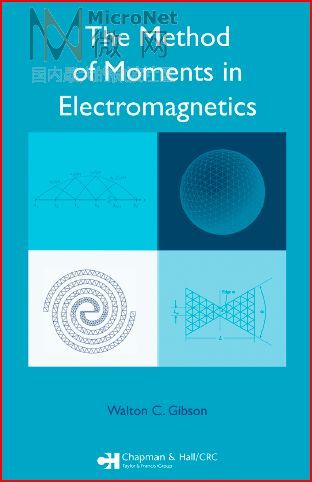The Method of Moments in Electromagnetics[原版非扫描]: 本帖最后由 masterchen 于 2009-10-20 20:01 编辑
继哈林登之后,又一本矩量法的书,原版出炉!:21bb
Contents
Preface ix
Acknowledgments xiii
About the Author xv
Chapter 1 Computational Electromagnetics 1
1.1 Computational Electromagnetics Algorithms 1
1.1.1 Low-FrequencyMethods 2
1.1.2 High-FrequencyMethods 2
References 4
Chapter 2 A Brief Review of Electromagnetics 5
2.1 Maxwell’s Equations 5
2.2 Electromagnetic Boundary Conditions 6
2.3 Formulations for Radiation 6
2.3.1 Three-Dimensional Green’s Function 8
2.3.2 Two-Dimensional Green’s Function 9
2.4 Vector Potentials 10
2.4.1 Magnetic Vector Potential 11
2.4.2 Electric Vector Potential 12
2.4.3 Comparison of Radiation Formulas 13
2.5 Near and Far Fields 14
2.5.1 Near Field 15
2.5.2 Far Field 16
2.6 Equivalent Problems 18
2.6.1 Surface Equivalent 18
2.6.2 Physical Equivalent 20
2.7 Surface Integral Equations 25
2.7.1 Electric Field Integral Equation 25
2.7.2 Magnetic Field Integral Equation 26
2.7.3 Combined Field Integral Equation 28
References 30
Chapter 3 The Method of Moments 33
3.1 Electrostatic Problems 33
3.1.1 ChargedWire 34
3.1.2 Charged Plate 39
3.2 The Method of Moments 43
3.2.1 Point Matching 44
3.2.2 Galerkin’s Method 44
3.3 Common Two-Dimensional Basis Functions 45
3.3.1 Pulse Functions 45
3.3.2 Piecewise Triangular Functions 45
3.3.3 Piecewise Sinusoidal Functions 46
3.3.4 Entire-Domain Functions 47
3.3.5 Number of Basis Functions 47
3.4 Solution of Matrix Equations 48
3.4.1 Gaussian Elimination 48
3.4.2 LU Decompositon 50
3.4.3 Condition Number 52
3.4.4 Iterative Methods 53
3.4.5 Examples 57
3.4.6 Commonly Used Matrix Algebra Software 58
References 61
Chapter 4 Thin Wires 63
4.1 Thin Wire Approximation 63
4.2 Thin Wire Excitations 65
4.2.1 Delta-Gap Source 65
4.2.2 Magnetic Frill 66
4.2.3 Plane Wave 67
4.3 Solving Hall´en’s Equation 68
4.3.1 Symmetric Problems 69
4.3.2 Asymmetric Problems 71
4.4 Solving Pocklington’s Equation 72
4.4.1 Solution by Pulse Functions and Point Matching 73
4.5 Thin Wires of Arbitrary Shape 73
4.5.1 Redistribution of EFIE Differential Operators 74
4.5.2 Solution Using Triangle Basis and Testing Functions 75
4.5.3 Solution Using Sinusoidal Basis and Testing Functions 77
4.5.4 Lumped and Distributed Impedances 78
4.6 Examples 79
4.6.1 Comparison of Thin Wire Models 79
4.6.2 Circular Loop Antenna 83
4.6.3 Folded Dipole Antenna 86
4.6.4 Two-Wire Transmission Line 87
4.6.5 Matching a Yagi Antenna 89
References 94
Chapter 5 Two-Dimensional Problems 95
5.1 Two-Dimensional EFIE 95
5.1.1 EFIE for a Strip: TM Polarization 95
5.1.2 Generalized EFIE: TM Polarization 100
5.1.3 EFIE for a Strip: TE Polariation 102
5.1.4 Generalized EFIE: TE Polarization 107
5.2 Two-Dimensional MFIE 109
5.2.1 MFIE: TM Polarization 109
5.2.2 MFIE: TE Polarization 111
5.3 Examples 113
5.3.1 Scattering by an Infinite Cylinder: TM Polarization 113
5.3.2 Scattering by an Infinite Cylinder: TE Polarization 115
References 124
Chapter 6 Bodies of Revolution 125
6.1 BOR Surface Description 125
6.2 Surface Current Expansion on a BOR 126
6.3 EFIE for a Conducting BOR 127
6.3.1 EFIE Matrix Elements 127
6.3.2 Excitation 130
6.3.3 Scattered Field 134
6.4 MFIE for a Conducting BOR 136
6.4.1 MFIE Matrix Elements 137
6.4.2 Excitation 140
6.4.3 Scattered Field 141
6.5 Notes on Software Implementation 141
6.5.1 Parallelization 141
6.5.2 Convergence 142
6.6 Examples 142
6.6.1 Galaxy 142
6.6.2 Conducting Sphere 142
6.6.3 EMCC Benchmark Targets 145
6.6.4 Biconic Reentry Vehicle 152
6.6.5 Summary of Examples 159
References 159
Chapter 7 Three-Dimensional Problems 161
7.1 Representation of Three-Dimensional Surfaces 161
7.2 Surface Currents on a Triangle 164
7.2.1 Edge Finding Algorithm 165
7.3 EFIE for Three-Dimensional Conducting Surfaces 167
7.3.1 EFIE Matrix Elements 167
7.3.2 Singular Matrix Element Evaluation 168
7.3.3 EFIE Excitation Vector Elements 176
7.3.4 Radiated Field 178
7.4 MFIE for Three-Dimensional Conducting Surfaces 179
7.4.1 MFIE Matrix Elements 179
7.4.2 MFIE Excitation Vector Elements 184
7.4.3 Radiated Field 184
7.4.4 Accuracy of RWG Functions in MFIE 184
7.5 Notes on Software Implementation 185
7.5.1 Memory Management 185
7.5.2 Parallelization 185
7.6 Considerations for Modeling with Triangles 187
7.6.1 Triangle Aspect Ratios 187
7.6.2 Watertight Meshes and T-Junctions 188
7.7 Examples 188
7.7.1 Serenity 189
7.7.2 RCS of a Sphere 189
7.7.3 EMCC Plate Benchmark Targets 189
7.7.4 Strip Dipole Antenna 198
7.7.5 Bowtie Antenna 199
7.7.6 Archimedean Spiral Antenna 201
7.7.7 Summary of Examples 204
References 205
Chapter 8 The Fast Multipole Method 209
8.1 The Matrix-Vector Product 210
8.2 Addition Theorem 210
8.2.1 Wave Translation 212
8.3 FMM Matrix Elements 213
8.3.1 EFIE Matrix Elements 213
8.3.2 MFIE Matrix Elements 214
8.3.3 CFIE Matrix Elements 215
8.3.4 Matrix Transpose 215
8.4 One-Level Fast Multipole Algorithm 215
8.4.1 Grouping of Basis Functions 215
8.4.2 Near and Far Groups 216
8.4.3 Number of Multipoles 216
8.4.4 Sampling Rates and Integration 218
8.4.5 Transfer Functions 219
8.4.6 Radiation and Receive Functions 220
8.4.7 Near-Matrix Elements 220
8.4.8 Matrix-Vector Product 221
8.4.9 Computational Complexity 222
8.5 Multi-Level Fast Multipole Algorithm (MLFMA) 222
8.5.1 Grouping via Octree 222
8.5.2 Matrix-Vector Product 223
8.5.3 Interpolation Algorithms 227
8.5.4 Transfer Functions 229
8.5.5 Radiation and Receive Functions 230
8.5.6 Interpolation Steps in MLFMA 230
8.5.7 Computational Complexity 231
8.6 Notes on Software Implementation 231
8.6.1 Initial Guess in Iterative Solution 231
8.6.2 Memory Management 232
8.6.3 Parallelization 234
8.6.4 Vectorization 234
8.7 Preconditioning 235
8.7.1 Diagonal Preconditioner 235
8.7.2 Block Diagonal Preconditioner 236
8.7.3 Inverse LU Preconditioner 236
8.7.4 Sparse Approximate Inverse 237
8.8 Examples 240
8.8.1 Bistatic RCS of a Sphere 240
8.8.2 EMCC Benchmark Targets 240
8.8.3 Summary of Examples 245
References 252
Chapter 9 Integration 255
9.1 One-Dimensional Integration 255
9.1.1 Centroidal Approximation 255
9.1.2 Trapezoidal Rule 256
9.1.3 Simpson’s Rule 258
9.1.4 One-Dimensional Gaussian Quadrature 259
9.2 Integration over Triangles 260
9.2.1 Simplex Coordinates 260
9.2.2 Radiation Integrals with a Constant Source 262
9.2.3 Radiation Integrals with a Linear Source 265
9.2.4 Gaussian Quadrature on Triangles 267
References 269
Index 271
强烈推荐,自己正在阅读中,感觉最大的优点在于数学推导简单明了,而且道理比较浅显易懂
:27bb
感谢楼主分享
非常感谢楼主无私奉献
不知道是谁写的呢。
不错的东东,学习下
听说讲的非常简单!
谢谢!!!下来看看
感谢楼主分享
感谢楼主分享 ,!!!!!!!!
好书啊,多谢楼主啊
好书一本,收藏了
Thank you for your sharing
hen hao, dui bi kan kan.
好!哈哈,{:5_231:}
谢谢楼主啊,好人啊。
谢谢楼主啊,敬礼{:7_1235:}
多谢分享!
谢谢楼主分享
谢谢分享
谢谢分享。。。。。。。。。。。。。。。。。
众里寻她千百度,,蓦然回首,那人却在灯火阑珊处


